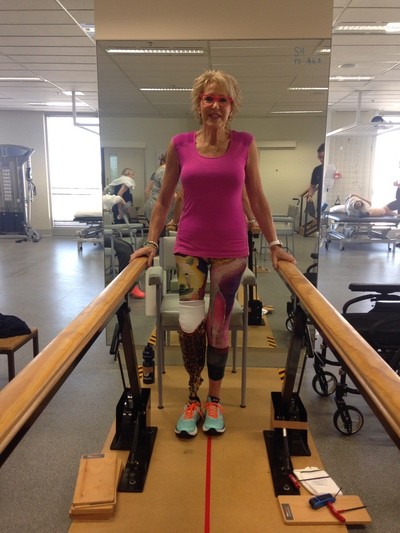With her leg pinned shattered under a truck, the future looked bleak for grandmother Jillian Nielsen. But ELISSA FRIDAY discovers the plucky ex-therapist dancing her cares away just 18 months later.
A beaming smile complements Jillian Nielsen’s youthful, energetic persona – and not even being literally hit by a truck can change that.
But the traumatic 2017 accident has still taken its toll, robbing the East Geelong grandmother of her 15-year career as a remedial therapist with an “enormous” clientele.
“I can no longer do that job because I can’t use all my life-force energy standing all day. I need that for my own rehabilitation now.”
Jillian’s life-changing accident came before sunrise on a cold June morning as she prepared to cross a road with friend Lorraine on the way to a central Geelong gym.
“When the green-man signal came we stepped out onto the crossing and, as we stepped out, in my peripheral vision I caught sight of a garbage truck hurtling around the corner,” Jillian remembers.
“We didn’t hear it because there was lots of machinery doing work on the road, so there was noise and it was still dark.”
Jillian saw the truck only when it was virtually upon her.
She yelled in alarm to Lorraine beside her.
“I threw her to the curb and myself with her,” Jillian says.
Lorraine “narrowly escaped” injury but Jillian was less fortunate.
“The truck actually came to a stand-still on my right leg,” Jillian recalls.
“Luckily I had my wits about me and yelled to Lorraine to go up to the driver and tell him to move about 12 inches forward so the back wheel didn’t go over me as well.
“He did that and I pulled my leg out from under the truck.”
The severity of the injury was confronting, Jillian says.
“All the bones splintered. I remember thinking, ‘You’re in a bit of trouble here, girl, but they’ll be able to fix it.”
But the “fur-lined, colourful, hot-pink, orange and neon-blue coat” she was wearing at the time was also on Jillian’s mind by the time help arrived.
“I can take them off myself – it’s only my leg,“ she remembers telling the paramedics.
“I just didn’t want them to ruin my clothes. I know it sounds ridiculous now.”
She remembers an “unknown” man cradling her at the scene, keeping her warm and conscious as she lost blood.
“I don’t know who he was but I’d like to tell him I’m very grateful for his care. I wish I could thank him personally.”
Jillian was first transported to University Hospital Geelong Hospital but remembers little after the trip, other than the subsequent helicopter ride to Melbourne’s The Alfred.
She lay on her back for two weeks as her leg bones were pinned with screws.
“I remember the nurses always smiling, but I had 14 operations in a period of about two months,” she grimaces.
Jillian’s daughters came from Adelaide, Perth and Barwon Heads “constantly” to be at her side.
“And Lorraine travelled to Melbourne to see me every day.”
But not every day was so bright, especially when the team of doctors concluded that nerves in her leg were severed.
“The skin and bones could repair but the nerves could never regenerate,” Jillian recalls.
Then she faced a terrible choice.
“It was mine, alone. If I kept my leg I would drag my foot forever and have multiple operations and be in constant pain, or I could have the below-knee amputation, which they suggested as a far-better option for me,” Jillian says.
The lifelong encumbrance of a lame foot seemed too much.
“I remember thinking, ‘I can’t do that’.”
So Jillian made the “best decision”, to go with the amputation.
“I’ve never regretted it, either,” she declares.
The experience taught Jillian that some things are just beyond the individual’s control, and must be “handed over to the professionals”.
“But I like to tell them, ‘I packaged it up in a beautiful parcel and I’m handing to you’.”
But some experiences during her treatment just couldn’t be handed over. In particular, the effects of the drug Ketamine, used during the amputation, took Jillian down to her lowest point.
“It was like the dungeon of the Earth,” she shudders.
“I couldn’t close my eyes. I saw visions of the most horrific things anyone could see, and I lay awake all night.
“There was nothing anyone could do. It was just all part of it.”
Jillian spent the following few months in a wheelchair, undergoing a skin graft along the way, before she was fitted with a prosthetic leg.
Her recovery included learning to walk on the prosthetic, while regular physiotherapy with an exercise physiologist helped re-build lost muscle.
But the biggest aid to Gillian’s recovery came from beyond hospital walls.
“Having that supportive network and beautiful family and friends assisting along the way with each step, pardon the pun, was the most inspiring thing of all for me,” she says.
Eighteen months later Gillian’s up and about but “still learning and getting adjustments made” to her prosthetic leg.
She recently upgraded to a design more-similar in appearance to her remaining left leg, and with a moving foot that helps her get about unaided.
“I’m delighted I can walk now,” Jillian says.
Despite the pain and long recovery, she believes that the accident actually changed her “for the better.“
In fact, Jillian’s so much better that she’s posting weekly Instagram videos of her dancing with daughter Julia.
“It’s an important part of my recovery. The old me worked very hard in my business and I didn’t devote much time for myself,” Jillian says.
“I don’t have flashbacks or mind-talking about the accident, and don’t talk about it much nowadays. I’m more of a listener to other people.
“I want to enjoy my life now and have beautiful experiences with my friends and family.”













